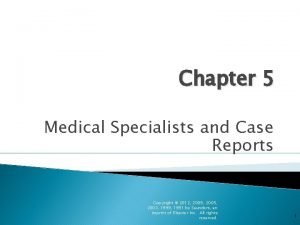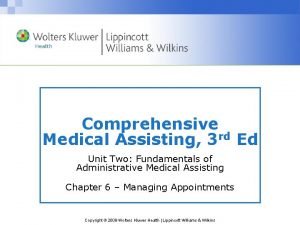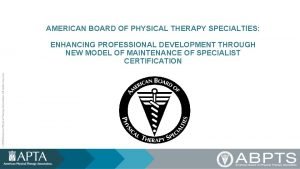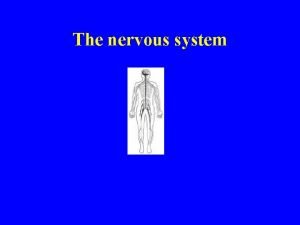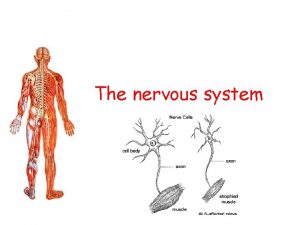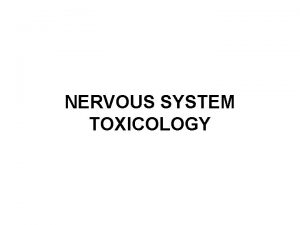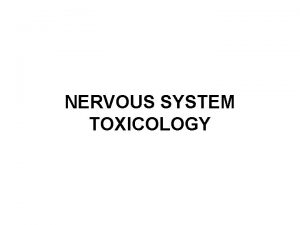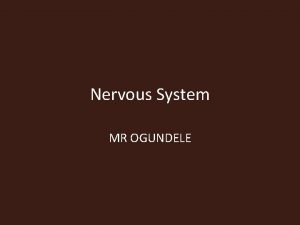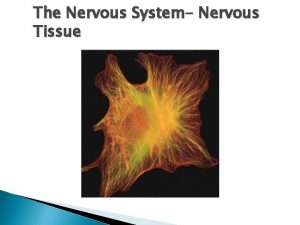Nervous System part 2 Medical Specialties of the



















- Slides: 19

Nervous System, part 2

Medical Specialties of the Nervous System 1. Anesthesiologist (an = ______ + esthes/i = _______ + -ologist = ______) administers anesthetic agents before and during surgery. www. questmedical. com/. . . /Anesthesiologist. jpg 2. Neurologist (neur/o = ______ + -ologist = ______) treats disorders of the nervous system 3. Neurosurgeon – performs surgery on the nervous system (i. e. brain surgeon)

Medical Specialties Cont’d. 4. Psychiatrist – treats chemical dependencies, emotional problems, and mental illness. 5. Psychologist – holds an advanced degree (other than a medical degree) and specializes in treating emotional problems. www. wmin. ac. uk/images/teaching. jpg

Pathology of Nervous System 1. Cephalgia – (cephal/o = _____ + -algia = ____ ), also known as a headache 2. Hydrocephalus – (hydr/o = water + cephal/o = head + -us = noun ending) abnormally increased amount of CSF in the brain Ventriculoperitoneal Shunt 1. Meningitis – inflammation of the meninges of the brain or spinal cord.

Pathology of Nervous System Cont’d 4. Alzheimer’s Disease – group of disorders associated with degenerative changes in the brain structure, may have memory loss, impaired cognition, and personality changes 5. Parkinson’s Disease – progressive, degenerative CNS disorder; symptoms include fine muscle tremors, mask-like facial expression, and shuffling gait (walk). Deep Brain Stimulation 6. Concussion – shaking up or jarring of the brain

Pathology of Nervous System Cont’d 7. Cerebral Contusion – bruise on the brain following injury to the head www. crash. lshtm. ac. uk/. . . /cerebralcontusion. jpg 8. Syncope – fainting; brief loss of consciousness caused by brief loss of oxygen to the brain 9. Coma – profound deep state of unconsciousness (no eye movements, no response to pain, no speech)

Pathology of Nervous System Cont’d 10. Stroke – also called cerebrovascular accident (CVA); damage to the brain when the blood flow is disrupted due to a clot or rupture of the vessel. memorylossonline. com 11. Transient Ischemic Attack (TIA) – temporary interruption in the blood supply to the brain

Pathology of Nervous System Cont’d 12. Multiple Sclerosis – progressive disorder caused by disruption of nerve impulses; symptoms include tremors, paralysis, and speech disturbance. 13. Cerebral palsy – injury to the brain occurring during pregnancy, birth, or soon after birth. Symptoms include poor muscle control, spasticity, and other neurological problems

Pathology of Nervous System Cont’d 14. Seizure – sudden, violent, involuntary contraction of a group of muscles caused by a disturbance in brain function. 15. Epilepsy – recurrent episodes of seizures www. nlm. nih. gov/. . . /ency/fullsize/19076. jpg

Who Wants to be a Mil-Neuron-Aire? ?

Mental Health Disorders 1. Mental Retardation – significantly below average intellectual functioning 2. Attention Deficit Disorder – short attention span and impulsiveness that is inappropriate for developmental age 3. Attention Deficit / Hyperactivity Disorder – pattern of inattention and hyperactivity that is inappropriate for developmental age

Mental Health Disorders Cont’d. 4. Addiction – compulsive, overwhelming involvement with a specific activity despite health, legal and social problems that it may cause www. meth-in-douglas. com/. . . /DSC 03427. JPG 5. Schizophrenia – psychotic disorder that can cause delusions, hallucinations, incoherent speech, and disruptive or catatonic behavior

Mental Health Disorders Cont’d. 6. Bipolar disorder – manic episodes that alternate with depressive episodes 7. Panic attack – intense feelings of apprehension, fearfulness, terror and impending doom. May have physical symptoms such as shortness of breath, profuse sweating, heart palpitations, chest pain and choking feeling 8. Phobia – irrational fear of a specific thing or situation. Some examples are acrophobia, agoraphobia, and claustrophobia

Mental Health Disorders Cont’d. 9. Hypochondriasis – fear of having a serious disease based on misinterpretation of bodily signs or symptoms 10. Kleptomania – recurrent failure to resist impulses to steal www. lmars. com/graphics/child-stealing. jpg 11. Munchausen syndrome by proxy – form of child abuse where abusive parents falsify an illness in a child by making up or creating symptoms, then seeking medical attention for the symptoms

Diagnostic Procedures 1. Electroencephalography (EEG) – (electr/o + encephal/o + -graphy) process of recording the electrical activity of the brain www. surgeryencyclopedia. com/images/gesu_01_im. . . 2. Myelography – radiographic study of the spinal cord after the injection of contrast medium.

Treatment Procedures 1. Mental Illness Medications – such as tranquilizers, antidepressants, antipsychotics, and psychotropic drugs 2. Pain Medications – such as analgesics, nonnarcotic and narcotic analgesics 3. Sedative/Hypnotic Medications – suppress the CNS system to produce calm and diminished responsiveness - such as sedatives, hypnotics, barbiturates, and anticonvulsants

Treatment Procedures Cont’d. 4. Anesthesia – (an- + -esthesia) the absence of normal sensation (especially to pain). Several types: topical, local, regional, epidural, spinal, general www. heart-valve-surgery. com 5. Electroshock therapy (ECT) – controlled seizure produced by passage of an electrical current through the brain. Used to treat depression and mental disorders that do not respond to other forms of therapy. 6. Neurectomy – removal of a nerve.

Career Opportunities 1. Anesthetist – administers anesthesia, not an MD (usually a nurse) 2. EEG technologist – performs EEG on patients 3. Electroneurodiagnostic technologist – performs EEG’s, nerve conduction studies, measures responses to stimuli 4. Polysomnographic technologist – sleep disorder studies 5. Social worker – trained to help people make adjustments in their lives, make referrals to outside agencies, etc…

Career Opportunities Cont’d. 6. Social services assistant – works with social worker, may do clerical functions 7. Mental health technician – works under psychiatrist or psychologist to help with care and rehabilitation 8. Art, music, dance therapist – use of creative arts for nonverbal expression of feelings 9. Recreational therapist – uses creative arts and activities such as field trips, to improve patients physical, emotional and mental wellbeing.
 Chapter 42 assisting in other medical specialties
Chapter 42 assisting in other medical specialties Identifying medical specialties chapter 7
Identifying medical specialties chapter 7 Chapter 42 assisting in other medical specialties
Chapter 42 assisting in other medical specialties Neural circuits the organization of neuronal pools
Neural circuits the organization of neuronal pools Nervous
Nervous Processes neuron
Processes neuron Neuroglia
Neuroglia Nervous system brain
Nervous system brain Group 2 specialties
Group 2 specialties Brie en croute pronunciation
Brie en croute pronunciation Mosc apta
Mosc apta Nervous system and digestive system
Nervous system and digestive system Endocrine system vs nervous system
Endocrine system vs nervous system General mechanism of hormone action
General mechanism of hormone action Endocrine system and nervous system
Endocrine system and nervous system Chemical messengers of the nervous system
Chemical messengers of the nervous system Roundworms nervous system
Roundworms nervous system The nervous system is made up of
The nervous system is made up of Three basic functions of the nervous system
Three basic functions of the nervous system Nervous system learning objectives
Nervous system learning objectives

